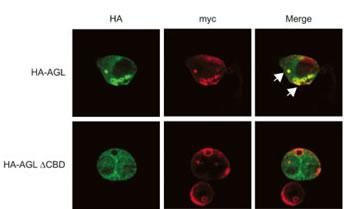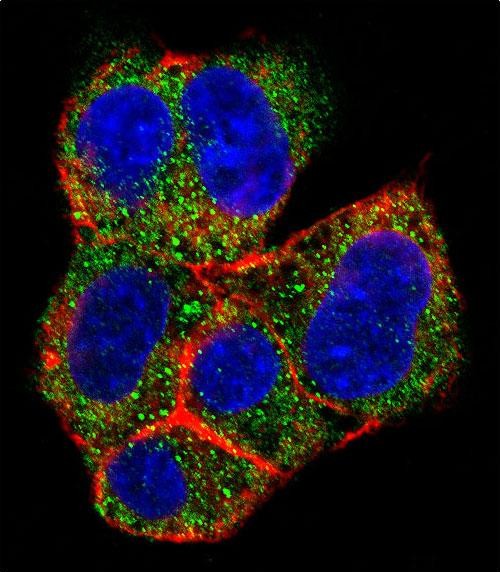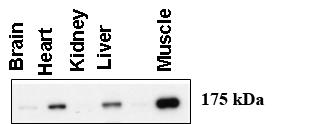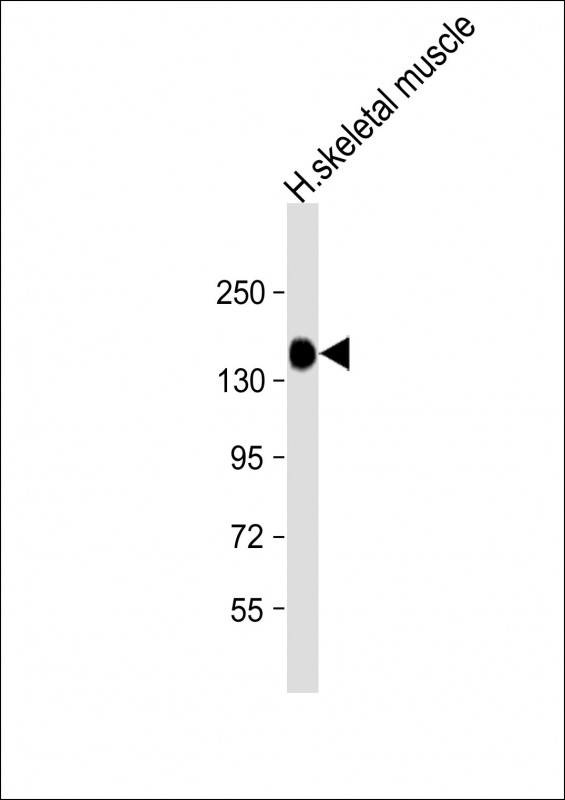AGL Antibody (C-term)
Purified Rabbit Polyclonal Antibody (Pab)
- SPECIFICATION
- CITATIONS: 6
- PROTOCOLS
- BACKGROUND

Application
| WB, IF, E |
|---|---|
| Primary Accession | P35573 |
| Reactivity | Human |
| Host | Rabbit |
| Clonality | Polyclonal |
| Isotype | Rabbit IgG |
| Calculated MW | 174764 Da |
| Antigen Region | 1479-1510 aa |
| Gene ID | 178 |
|---|---|
| Other Names | Glycogen debranching enzyme, Glycogen debrancher, 4-alpha-glucanotransferase, Oligo-1, 4-1, 4-glucantransferase, Amylo-alpha-1, 6-glucosidase, Amylo-1, 6-glucosidase, Dextrin 6-alpha-D-glucosidase, AGL, GDE |
| Target/Specificity | This AGL antibody is generated from rabbits immunized with a KLH conjugated synthetic peptide between 1479-1510 amino acids from the C-terminal region of human AGL. |
| Dilution | WB~~1:8000 IF~~1:10~50 E~~Use at an assay dependent concentration. |
| Format | Purified polyclonal antibody supplied in PBS with 0.09% (W/V) sodium azide. This antibody is prepared by Saturated Ammonium Sulfate (SAS) precipitation followed by dialysis against PBS. |
| Storage | Maintain refrigerated at 2-8°C for up to 2 weeks. For long term storage store at -20°C in small aliquots to prevent freeze-thaw cycles. |
| Precautions | AGL Antibody (C-term) is for research use only and not for use in diagnostic or therapeutic procedures. |
| Name | AGL |
|---|---|
| Synonyms | GDE |
| Function | Multifunctional enzyme acting as 1,4-alpha-D-glucan:1,4- alpha-D-glucan 4-alpha-D-glycosyltransferase and amylo-1,6-glucosidase in glycogen degradation. |
| Cellular Location | Cytoplasm. Note=Under glycogenolytic conditions localizes to the nucleus |
| Tissue Location | Liver, kidney and lymphoblastoid cells express predominantly isoform 1; whereas muscle and heart express not only isoform 1, but also muscle-specific isoform mRNAs (isoforms 2, 3 and 4). Isoforms 5 and 6 are present in both liver and muscle |

Provided below are standard protocols that you may find useful for product applications.
Background
AGL is a glycogen debrancher enzyme which is involved in glycogen degradation. This enzyme has two independent catalytic activities which occur at different sites on the protein: a 4-alpha-glucotransferase activity and a amylo-1,6-glucosidase activity. Mutations in the AGL gene are associated with glycogen storage disease although a wide range of enzymatic and clinical variability occurs which may be due to tissue-specific alternative splicing.
References
Horinishi, A., et al., J. Hum. Genet. 47(2):55-59 (2002).
Bao, Y., et al., Genomics 38(2):155-165 (1996).
Yang, B.Z., et al., J. Biol. Chem. 267(13):9294-9299 (1992).
Yang-Feng, T.L., et al., Genomics 13(4):931-934 (1992).
Bao, Y., et al., Gene 197 (1-2), 389-398 (1997).
If you have used an Abcepta product and would like to share how it has performed, please click on the "Submit Review" button and provide the requested information. Our staff will examine and post your review and contact you if needed.
If you have any additional inquiries please email technical services at tech@abcepta.com.














 Foundational characteristics of cancer include proliferation, angiogenesis, migration, evasion of apoptosis, and cellular immortality. Find key markers for these cellular processes and antibodies to detect them.
Foundational characteristics of cancer include proliferation, angiogenesis, migration, evasion of apoptosis, and cellular immortality. Find key markers for these cellular processes and antibodies to detect them. The SUMOplot™ Analysis Program predicts and scores sumoylation sites in your protein. SUMOylation is a post-translational modification involved in various cellular processes, such as nuclear-cytosolic transport, transcriptional regulation, apoptosis, protein stability, response to stress, and progression through the cell cycle.
The SUMOplot™ Analysis Program predicts and scores sumoylation sites in your protein. SUMOylation is a post-translational modification involved in various cellular processes, such as nuclear-cytosolic transport, transcriptional regulation, apoptosis, protein stability, response to stress, and progression through the cell cycle. The Autophagy Receptor Motif Plotter predicts and scores autophagy receptor binding sites in your protein. Identifying proteins connected to this pathway is critical to understanding the role of autophagy in physiological as well as pathological processes such as development, differentiation, neurodegenerative diseases, stress, infection, and cancer.
The Autophagy Receptor Motif Plotter predicts and scores autophagy receptor binding sites in your protein. Identifying proteins connected to this pathway is critical to understanding the role of autophagy in physiological as well as pathological processes such as development, differentiation, neurodegenerative diseases, stress, infection, and cancer.




